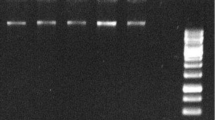Abstract
We have developed a protocol for isolating milligram quantities of highly purified DNA from tomato nuclei. The protocol utilizes fresh seedlings or leaves without freezing. Tissues are treated with ethyl ether, thoroughly washed, and placed in a buffer containing the nuclear-stabilizing agent 2-methyl-1,4-pentanediol. Nuclei are liberated from tomato cells by homogenization in a Waring blender. The interaction of nuclear DNA with oxidized polyphenols is inhibited by compounds that adsorb polyphenols or prevent oxidation reactions. Chloroplasts and mitochondria are preferentially eliminated with Triton X-100. Nuclei are concentrated using a Percoll gradient and lysed with SDS. DNA is subsequently purified by RNase and protease digestions and phenol/chloroform extractions. The isolated DNA is essentially free of polyphenols and other major contaminants based upon its lack of coloration, A260/A280 ratio, digestibility with restriction enzymes, melting profile, and reassociation properties.
Similar content being viewed by others
References
Couch, J.A. and P.J. Fritz. 1990. Isolation of DNA from plants high in polyphenolics. Plant Mol. Biol. Reptr. 8:8–12.
Guillemaut, P. and L. Maréchal-Drouard. 1992. Isolation of plant DNA: A fast, inexpensive, and reliable method. Plant Mol. Biol. Reptr. 10:60–65.
Hamilton, R.H., U. Künsch and A. Temperli. 1972. Simple rapid procedures for isolation of tobacco leaf nuclei. Analyt. Biochem. 49:48–57.
Katterman, F.R.H. and V.I. Shattuck. 1983. An effective method of DNA isolation from the mature leaves ofGossypium species that contain large amounts of phenolic terpenoids and tannins. Preparative Biochem. 13:347–359.
Leutwiler L.S., B.R. Hough-Evans and E.M. Meyerowitz. 1984. The DNA ofArabidopsis thaliana. Mol. Gen. Genet. 194:15–23.
Loomis, W.D. 1974. Overcoming problems of phenolics and quinones in the isolation of plant enzymes and organelles. Meth. Enzymology 31:528–544.
Peterson, D.G. and S.M. Stack. 1997a. A method for isolating milligram quantities of “polyphenol-free” nuclear DNA from tomato. Report Tomato Genet. Coop. 46:in press.
Peterson, D.G. and S.M. Stack. 1997b. Characterization of the tomato genome using Cot analysis. Report Tomato Genet. Coop. 46:in press.
Peterson, D.G. and S.M. Stack. 1997c. GC content for tomato DNA based on DNA melting. Report Tomato Genet. Coop. 46in press.
Sambrook, J., E.F. Fritsch and T. Maniatis. 1989.Molecular Cloning: A Laboratory Manual, 2nd edition, C. Nolan, ed. Cold Spring Harbor, NY: Cold Spring Harbor Laboratory Press.
Watson, J.C. and W.F. Thompson. 1986. Purification and restriction endonuclease analysis of plant nuclear DNA. Meth. Enzymology 118:57–79.
Author information
Authors and Affiliations
Rights and permissions
About this article
Cite this article
Peterson, D.G., Boehm, K.S. & Stack, S.M. Isolation of milligram quantities of nuclear DNA from tomato (Lycopersicon esculentum), A plant containing high levels of polyphenolic compounds. Plant Mol Biol Rep 15, 148–153 (1997). https://doi.org/10.1007/BF02812265
Issue Date:
DOI: https://doi.org/10.1007/BF02812265




